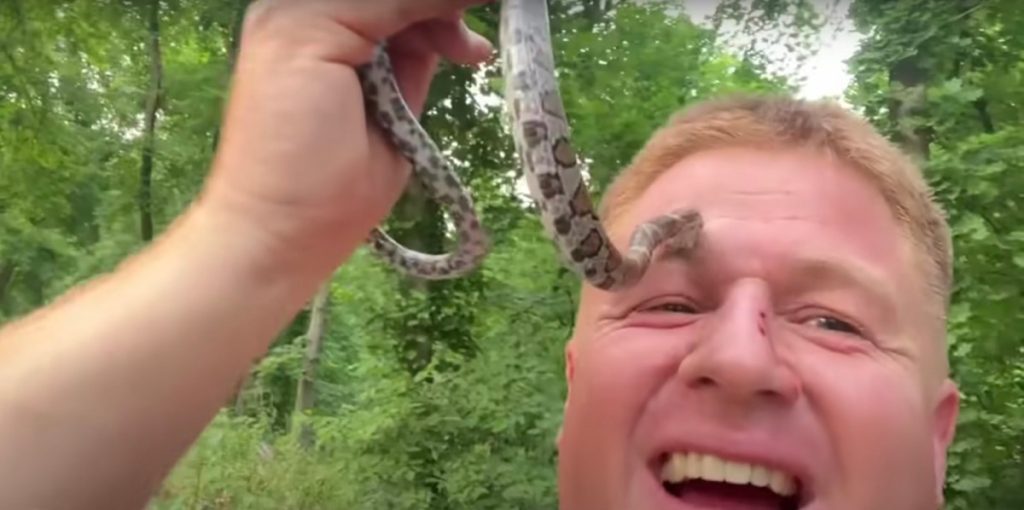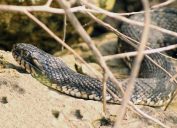Expert Shares What Not to Do When You See a Snake After Being Bitten 50 Times
The encounter occurred when he noticed the reptile trying to cross the road during a bike ride.

Most people go to great lengths to avoid snakes when they're out in nature. Despite the fact that most species are completely harmless, there's always the chance you might come across a potentially venomous variety whose bite could land you in the hospital with serious injuries. But in one recent encounter, a reptile expert took the opportunity to explain what exactly not to do when you see a snake after documenting himself getting bitten more than 50 times. Read on to see how you can avoid the same fate.
READ THIS NEXT: 8 Plants That Will Keep Snakes Out of Your Yard, According to Pest Experts.
A reptile expert subjected himself to more than 50 snake bites during a recent educational video.

Coming across a snake in nature isn't always a frightening experience if you're able to carefully observe them from afar. But in a recently posted YouTube video, Jesse Rothacker, director and founder of Forgotten Friend Reptile Sanctuary, documented an encounter that ended up with him being bitten by a snake more than 50 times.
Rothacker begins his video by pointing out an Eastern milk snake along the side of a bike path in Pennsylvania, which he immediately explains is non-venomous. As an expert, he then approaches the full-grown snake and picks it up to explain to viewers the importance of the species in the food chain and its specific characteristics. But while he's very careful in handling the animal and even complimenting its curiosity, the milk snake can't help but nibble on the director dozens of times with tiny "tasting" bites.
Rothacker uses the video as an educational moment about how some reptile species act in the wild.

Throughout the video, Rothacker manages to get a few key facts about the species, such as that it's "famous for eating other snakes"—including venomous species. He even notices the relatively small reptile making a particular movement with its tail, which some would equate with rattlesnakes.
"Most snakes—venomous or not—use that tail [shake] as a warning sign," he explains. "They don't have vocal cords, so they make noise with their tails."
He then manages to gently pick up the snake to show it off to the camera. But almost immediately, the reptile begins to slowly bite Rothacker as he moves around, getting his arm, fingers, t-shirt, shorts, and legs while trying to stay focused on explaining facts.
"This guy is very bitey. But except for being bitey, he's very nice!" he said while laughing, explaining that most species will often stop biting after a few attempts. "He's pretty much going to keep biting me. He's so funny the way he keeps biting me!"
RELATED: For more up-to-date information, sign up for our daily newsletter.
He explained that the snake wasn't trying to hurt him with all those bites.

Eventually, the snake manages to bite him on the eyebrow and the nose, totaling 52 nibbles before he gently lets the animal go in a hollow log. But despite the high bite count, he explained that the reptile wasn't trying to hurt him.
"You can see in the video I'm laughing a lot every time he bites me because I know he's not trying to hurt me!" Rothacker told local FOX affiliate WPMT in an interview on June 13. "The way that milk snakes explore is with their mouth, and so [they] don't have a powerful defensive bite, they just will slowly grab on to everything that they're curious about."
During the video, he equates the little nibbles more to "tasting" than he does a violent or angry response. He adds that he's been bitten "thousands of times" but that this particular species is just trying to figure out what might be in their diet and what isn't—despite repeatedly sinking its tiny teeth into him.
He explains that you can avoid a similar fate by following a few simple rules.

Once Rothacker safely released the snake further away from the bike path, he explained that despite what had just happened to him, most people wouldn't have anything to fear from the species if they were to come across one themselves. "They will not bite you if you don't pick them up!" he said as the reptile slithered away.
He went on to explain that non-venomous species really aren't a cause for concern for most people. "Harmless snakes really are harmless," he said. "Just wear gardening gloves or long sleeves if you're worried at all about these tiny teeth."
Of course, as a snake expert, he could immediately identify the milk snake. But thanks to modern technology, you can still get a quick response if you encounter an unknown reptile in the wild. "The best tool you have when you meet a snake is the cellphone in your pocket, pull the rectangle out of your pants and take a picture of the snake from a safe distance, five or ten feet away," Rothacker told WPMT. Then, you can compare it to other images of snakes online to determine the type.
Otherwise, you can also avoid being caught off guard by snakes by being extra careful when dealing with their typical hiding spots. "Places that humans would see a lot that have great cover for snakes would be firewood piles, underneath dog bowls or toys that would be left outside, underneath tarps, piles of leaves or sticks, natural debris, would be good hiding places for snakes," Kat Dale, lead zookeeper at the Kentucky Reptile Zoo, recently told local Richmond, Virginia CBS affiliate WYMT.





















